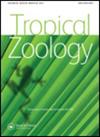What is driving the community structure of insects in arid ecosystems of Southern Africa? An example with blister beetles (Coleoptera: Meloidae)
IF 0.4
4区 生物学
Q4 ZOOLOGY
引用次数: 2
Abstract
A considerable part of community ecology literature questioned what are the main drivers of ecological relationships in an organismal community. We analysed this focal question by studying blister beetle (Meloidae) assemblages in Southern Africa. We explored the ecological distribution of 48 species across underlying bioclimatic (e.g. temperatures and precipitation regimes), environmental factors (biomes, vegetation structure) and the taxonomic heterogeneity of each groups inhabiting major biomes of Namibia across their main biological and ecological traits, by Canonical Correspondence in order to get an ordination plot. Monte Carlo methods were used to test for randomness of the data ordination. Ordination plot identified three main assemblages, one being constituted by strictly semiarid savannah species (camelthorn, mountain, karstweld, thornbush, mixed tree and shrub, dwarf shrub, mopane and forest savannahs), one much larger and less homogenous second assemblage, inclusive of more generalist species from Karoo and semi-desert habitats, living also in arid savannahs, and the third one including Nama Karoo species. All the three assemblages were taxonomically very heterogeneous, showing that phylogenetic relationships are probably less relevant than interspecific ecological relationships among species of the same group to determine present-day community structure in these animals.是什么推动了非洲南部干旱生态系统中昆虫的群落结构?以水疱甲虫为例(鞘翅目:虫科)
相当一部分群落生态学文献质疑有机群落中生态关系的主要驱动因素是什么。我们通过研究非洲南部的水疱甲虫(水疱甲虫科)组合来分析这个焦点问题。利用典型对应方法,研究了48个物种在不同生物气候(如温度和降水)、环境因子(生物群落、植被结构)下的生态分布,以及在纳米比亚主要生物群落中各类群的主要生物和生态特征的分类学异质性,以获得排序图。采用蒙特卡罗方法检验数据排序的随机性。排序样地确定了三个主要组合,一个是由严格的半干旱稀树草原物种组成的(骆驼刺、山地、喀山、荆棘、混交树和灌木、矮灌木、毛木和森林稀树草原),一个更大但不太均匀的第二组合,包括来自卡鲁和半沙漠生境的更多的通才物种,也生活在干旱的稀树草原上,第三个包括纳玛卡鲁物种。所有这三个组合在分类上都非常异质,这表明在确定这些动物当今的群落结构时,系统发育关系可能不如同一类群物种之间的种间生态关系相关。
本文章由计算机程序翻译,如有差异,请以英文原文为准。
求助全文
约1分钟内获得全文
求助全文
来源期刊

Tropical Zoology
生物-动物学
CiteScore
2.50
自引率
0.00%
发文量
1
审稿时长
>12 weeks
期刊介绍:
Tropical Zoology is an international zoological journal publishing original papers in the field of systematics, biogeography, phylogeny, ecology and conservation of all terrestrial and aquatic animal Phyla from tropical and subtropical areas.
Only papers with new information, high quality and broad interest are considered. Single species description and checklists are not normally accepted. Review papers are welcome. The journal is owned by the Istituto di Ricerca sugli Ecosistemi Terrestri of the Consiglio Nazionale delle Ricerche, Florence, Italy (CNR-IRET) who performs research into the structure and functioning of aquatic and terrestrial ecosystems, focusing in particular on anthropogenic pressure and global change. The knowledge amassed forms the scientific basis for identifying the most appropriate protective and corrective interventions, and provides support for the bodies entrusted with formulating policies for environmental protection and recovery.
 求助内容:
求助内容: 应助结果提醒方式:
应助结果提醒方式:


